German expressionism - Study guides, Class notes & Summaries
Looking for the best study guides, study notes and summaries about German expressionism? On this page you'll find 64 study documents about German expressionism.
Page 3 out of 64 results
Sort by
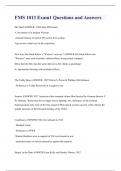
-
FMS 1013 Exam1 Questions and Answers
- Exam (elaborations) • 13 pages • 2024
-
- $7.99
- + learn more
FMS 1013 Exam1 Questions and Answers Die Hard ANSWER -1988 John McTiernan -Conventions of a modern Western -unusual because of typical 80's action hero casting -big on non-verbal cues in the exposition How does Die Hard follow a "Western" story arc? ANSWER Die Hard follows the "Western" story arch (outsider, outlawed hero, strong moral compass) Show that the Hero has the same skill set as the villain, a gunslinger Ie: spectacular shooting with nonlethal effects The Teddy Bear...
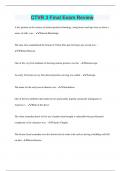
-
CTVR 3 Final Exam Review
- Exam (elaborations) • 10 pages • 2024
- Available in package deal
-
- $9.99
- + learn more
CTVR 3 Final Exam Review A key pioneer in the science of motion picture technology, using horses and trip wires to shoot a series of stills, was: - Edward Muybridge The man who standardized the format of 35mm film and 24 frames per second was: - William Dickson One of the very first methods of showing motion pictures was the: - Kinetoscope An early Victorian-era toy that showed pictures moving was called: - Zoetrope The name for the early movie theaters was - Nickelodeon One ...
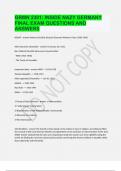
-
GRMN 2301 INSIDE NAZY GERMANY FINAL EXAM QUESTIONS AND ANSWERS
- Exam (elaborations) • 15 pages • 2023
- Available in package deal
-
- $14.49
- + learn more
World War II Experimentation Expansion Culmination Death Throws Kristallnacht November 9, 1938 Wansee Conference January 20, 1942 Total War Speech February 18, 1943 Wansee Conference Meeting of Nazi leaders in Berlin. It was the decision to murder the Jews (The Final Solution) (January 20, 1942) Kristallnacht "Night of Broken Glass" Nazis in Germany torched synagogues, vandalized Jewish homes, schools, and businesses and kille...
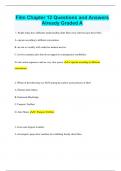
-
Film Chapter 12 Questions and Answers Already Graded A
- Exam (elaborations) • 15 pages • 2023
- Available in package deal
-
- $9.99
- + learn more
Film Chapter 12 Questions and Answers Already Graded A 1. People today have difficulty understanding older films most often because those films A. operate according to different conventions. B. are not as visually well-crafted as modern movies. C. involve romantic plots that do not appeal to contemporary sensibilities. D. lack action sequences and are very slow paced. A. operate according to different conventions. 2. Which of the following was NOT among the earliest early pioneers of film? ...
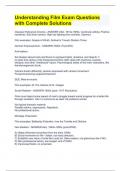
-
Understanding Film Exam Questions with Complete Solutions
- Exam (elaborations) • 8 pages • 2024
-
Available in package deal
-
- $11.49
- + learn more
Classical Hollywood Cinema - ANSWER-USA. 1910s-1960s. Continuity editing. Positive narratives. Eye-level camera. High key lighting (low contrast). Glamour. Film examples: Grapes of Wrath, Sullivan's Travels, Modern Times German Expressionism - ANSWER-1920s. Post-WWI. Anti-realism. Set designs absurd sets and floors to represent lights, shadows, and objects. T he plots and stories of the Expressionist films often dealt with madness, insanity, betrayal, and other "intellectual" t...

-
Vertigo A* revision notes
- Summary • 9 pages • 2024
-
- $9.59
- + learn more
Vertigo (Alfred Hitchcock) notes for an A* in A Level. This document contains the following topics: Hitchcock as an auteur Voyeurism German Expressionism Cinematography Vertigo Context Key sequence analysis Motifs Laura Mulvey, Visual Pleasures and Narrative Cinema (1975) notes
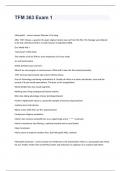
-
TFM 363: Exam 1 questions and complete correct answers 2024
- Exam (elaborations) • 5 pages • 2024
-
- $14.99
- + learn more
Metropolis! - correct answer Director: Fritz Lang After 1927 release, a quarter of Lang's original version was cut from the film. The footage was believed to be lost until discovered in a small museum in Argentina 2008. Era: World War I "Holy Grail" of film finds The mother of all sci-fi films; most important sci-fi ever made AI, and Social justice Divide between poor and rich, . What if we can program a consciousness. What will it mean for the society/humanity 1927 German expression...
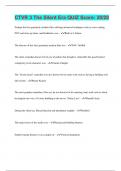
-
CTVR 3 The Silent Era QUIZ Score: 20/20
- Exam (elaborations) • 3 pages • 2024
- Available in package deal
-
- $8.99
- + learn more
CTVR 3 The Silent Era QUIZ Score: 20/20 Perhaps the first genuinely modern film, utilizing advanced techniques such as cross-cutting, POV and close-up shots, and flashbacks was: - Birth of a Nation The director of this first genuinely modern film was: - D.W. Griffith The silent comedian known for his use of pathos that brought a vulnerable-but-good hearted complexity to his character was: - Charles Chaplin The "frozen-faced" comedian was also known for his stunt work such as havi...

-
FMS 1013 Exam #1 Exam 2023/2024
- Exam (elaborations) • 9 pages • 2023
-
- $11.49
- + learn more
Die Hard - ANSWER--1988 John McTiernan -Conventions of a modern Western -unusual because of typical 80's action hero casting -big on non-verbal cues in the exposition How does Die Hard follow a "Western" story arc? - ANSWER-Die Hard follows the "Western" story arch (outsider, outlawed hero, strong moral compass) Show that the Hero has the same skill set as the villain, a gunslinger Ie: spectacular shooting with nonlethal effects The Teddy Bears - ANSWER--1907 Edwin S. Porter & W...
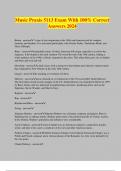
-
Music Praxis 5113 Exam With 100% Correct Answers 2024
- Exam (elaborations) • 37 pages • 2024
- Available in package deal
-
- $14.49
- + learn more
Music Praxis 5113 Exam With 100% Correct Answers 2024 Bebop - answer`a type of jazz originating in the 1940s and characterized by complex harmony and rhythms. It is associated particularly with Charlie Parker, Thelonious Monk, and Dizzy Gillespie. Blues - answermelancholic music of black American folk origin, typically in a twelve-bar sequence. It developed in the rural southern US toward the end of the 19th century, finding a wider audience in the 1940s as blacks migrated to the cities. ...

That summary you just bought made someone very happy. Also get paid weekly? Sell your study resources on Stuvia! Discover all about earning on Stuvia


